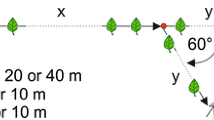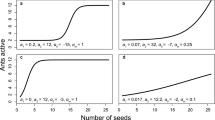Abstract
Gnamptogenys moelleri nests in bromeliads and feeds on an array of food items, including dead and live animals, and nectar. Field data in Brazilian forests indicate that G. moelleri hunts solitarily, while retrieving is performed both by solitary workers for small items, or by a group of recruited workers for large items. This flexible foraging strategy was investigated in the laboratory through a series of experiments to assess the context in which recruitment is elicited. Three types of food were used: 50% honey solution, large insect prey, and cluster of small insects. For all food types the first encounter by a scout resulted in increased numbers of ants leaving the nest and finding the food in the arena. After finding liquid food or large prey, the forager returns to the nest and transmits information to nestmates about food location on the substrate. The successful scout repeatedly taps the sting on the ground, and recruited ants collectively retrieve the large insect to the nest. On the other hand, there is no transmission of information to nestmates about the location of small clumped prey, although the returning scout induces nestmates to leave the nest and hunt. Because foraging in G. moelleri is restricted mostly to the nest bromeliad, and small worker size (0.5 cm) precludes capturing large prey solitarily, recruitment behavior widens the spectrum of food items consumed by this ant species. Although recruitment behavior in ponerines has already been reported to vary with the type and size of a food source, this study also shows that the transmission of information about food location depends on the type of food found (large prey or liquid food versus cluster of small prey).
Similar content being viewed by others
REFERENCES
Attygalle, A. B., and Morgan, E. D. (1985). Ant trail pheromones. Adv. Insect Physiol. 18: 1–30.
Baroni-Urbani, C. (1993). The diversity and evolution of recruitment behavior in ants, with a discussion of the usefulness of parsimony criteria in the reconstruction of evolutionary histories. Insectes Soc. 40: 233–260.
Barros, F., Melo, M. M. R. F., Chiea, S. A. C., Kirizawa, M., Wanderley, M. G. L., and Jung-Mendaçolli, S. L. (1991). Flora fanerogâmica da Ilha do Cardoso, 1, Instituto de Botânica, São Paulo, Brazil.
Beckers, R., Goss, S., Deneubourg, J. L., and Pasteels, J.M. (1989). Colony size, communication and ant foraging strategy. Psyche 96: 239–256.
Bestmann, H. J., Janssen, E., Kern, F., and Liepold, B. (1995). All-trans geranylgeranyl acetate and geranylgeraniol, recruitment pheromone components in the Dufour gland of the ponerine ant Ectatomma ruidum. Naturwissenschaften 82: 334–336.
Bhatkar, A., and Whitcomb, W. H. (1970). Artificial diet for rearing various species of ants. Fla. Entomol. 53: 229–232.
Blatrix, R., and Jaisson, P. (2000). Optional gamergates in the queenright ponerine ant Gnamptogenys striatula Mayr. Insectes Soc. 47: 193–197.
Blatrix, R., Schulz, C. M., Jaisson, P., Francke, W., and Hefetz, A. (2002). Trail pheromone of ponerine ant Gnamptogenys striatula: 4-Methylgeranyl ester from Dufour's gland. J. Chem. Ecol. 28: 2557–2567.
Bolton, B. (1995). A taxonomic and zoogeographical census of the extant ant taxa (Hymenoptera: Formicidae). J. Nat. Hist. 29: 1037–1056.
Breed, M. D., Fewell, J. H., Moore, A. J., and Williams, K. R. (1987). Graded recruitment in a ponerine ant. Behav. Ecol. Sociobiol. 20: 407–411.
Carroll, C. R., and Janzen, D. H. (1973). Ecology of foraging by ants. Annu. Rev. Ecol. Syst. 4: 231–257.
Cerdé, X., Retana, J., and Cros, S. (1997). Thermal disruption of transitive hierarchies in Mediterranean ant communities. J. Anim. Ecol. 66: 363–374.
Cogni, R., and Oliveira, P. S. (2004). Patterns in foraging and nesting ecology in the arboreal neotropical ponerine ant, Gnamptogenys moelleri. Insectes Soc. 51: 123–130.
Dejean, A., Lachaud, J. P., and Beugnon, G. (1993). Efficiency in the exploitation of patchy environments by the ponerine ant Paltothyreus tarsatus: an ecological consequence of the flexibility of prey capture behavior. J. Ethol. 11: 43–53.
Del-Claro, K., and Oliveira, P. S. (1996). Honeydew flicking by treehoppers provides cues to potential tending ants. Anim. Behav. 51: 1071–1075.
Detrain, C., and Deneubourg, J.L. (2002). Complexity of environment and parsimony of decision rules in insect societies. Biol. Bull. 202: 268–274.
Fourcassié, V., and Oliveira, P. S. (2002). Foraging ecology of the giant Amazonian ant Dinoponera gigantea (Hymenoptera, Formicidae, Ponerinae): Activity schedule, diet, and spatial foraging patterns. J. Nat. Hist. 36: 2211–2227.
Giraud, T., Blatrix, R., Poteaux, C., Solignac, M., and Jaisson, P. (2000). Population structure and mating biology of the polygynous ponerine ant Gnamptogenys striatula in Brazil. Mol. Ecol. 9: 1835–1841.
Gobin, B., Billen, J., and Peeters, B. C. (2001). Dominance interactions regulate worker mating in the polygynous ponerine ant Gnamptogenys menadensis. Ethology 107: 495–508.
Gobin, B., Peeters, C., and Billen, J. (1998a). Colony reproduction and arboreal life in the ponerine ant Gnamptogenys menadensis (Hymenoptera: Formicidae). Neth. J. Zool. 48: 53–63.
Gobin, B., Peeters, C., Billen, J., and Morgan, E. D. (1998b). Interpecific trail following and commensalism between the ponerine ant Gnamptogenys menadensis and the formicine ant Polyrhachis rufipes. J. Insect Behav. 11: 361–369.
Hölldobler, B. (1984a). Evolution of insect communication. In Lewis, T. (ed), Insect Communication, Academic Press, London, pp. 349–377.
Hölldobler, B. (1984b). Communication during foraging and nest-relocation in the African stink ant, Paltothyreus tarsatus Fabr. (Hymenoptera, Formicidae, Ponerinae). Z. Tierpsychol. 65: 40–52.
Hölldobler, B., and Wilson E. O. (1990). The Ants, Harvard University Press, Cambridge, MA.
Johnson, C. A., Lommelen, E., Allard, D., and Gobin, B. (2003). The emergence of collective foraging in the arboreal Gnamptogenys menadensis (Hymenoptera: Formicidae). Naturwissenschaften 90: 332–336.
Keller, R. A. (2000). Cladistics of the tribe Ectatommini (Hymenoptera: Formicidae): A reappraisal. Insect Syst. Evol. 31: 59–69.
Lachaud, J. P., and Dejean, A. (1994). Predatory behavior of a seed-eating ant: Brachyponera senaarensis. Entomol. Exp. Appl. 72: 145–155.
Lattke, J. E. (1994). Phylogenetic relationships and classification of Ectatommine ants (Hymenoptera: Formicidae). Entomol. Scand. 25: 105–119.
Lattke, J. E. (1995). Revision of the ant genus Gnamptogenys in the NewWorld (Hymenoptera: Formicidae). J. Hym. Res. 4: 137–193.
Liefke, C., Hölldobler, B., and Maschwitz, U. (2001). Recruitment behavior in the ant genus Polyrhachis (Hymenoptera, Formicidae). J. Insect Behav. 14: 637–657.
Oliveira, P. S., and Hölldobler, B. (1989). Orientation and communication in the neotropical ant Odontomachus bauri Emery (Hymenoptera, Formicidae, Ponerinae). Ethology 83: 154–166.
Overal, W. L. (1986). Recrutamento e divisão de trabalho em col ônias naturais da formiga Ectatomma quadridens (Fabr.) (Hymenoptera: Formicidae: Ponerinae). Bol. Mus. Para. Emilio Goeldi Zoologia 2: pp113–135.
Paiva, R. V. S., and Brandão, C. R. F. (1989). Estudos sobre a organização social de Ectatomma permagnum Forel, 1908 (Hymenoptera: Formicidae). Rev. Bras. Biol. 49: 783–792.
Peeters, B.C., and Crewe, R. (1987). Foraging and recruitment in ponerine ants: Solitary hunting in the queenless Ophthalmopone berthoudi (Hymenoptera: Formicidae). Psyche 94: 201–214.
Pratt, S. C. (1989). Recruitment and other communication behavior in the ponerine ant Ectatomma ruidum. Ethology 81: 313–331.
Pratt, S. C. (1994). Ecology and behavior of Gnamptogenys horni (Formicidae: Ponerine). Insectes Soc. 41: 255–262.
Schatz, B., Lachaud, J. P., and Beugnon, G. (1997). Graded recruitment and hunting strategies linked to prey weight and size in the ponerine ant Ectatomma ruidum. Behav. Ecol. Sociobiol. 40: 337–349.
Traniello, J. F. A. (1982). Population structure and social organization in the primitive ant Amblyopone pallipes (Hymenoptera: Formicidae). Psyche 89: 65–80.
Traniello, J. F. A. (1987). Comparative foraging ecology of north temperate ants: The role of worker size and cooperative foraging in prey selection. Insectes Soc. 34: 118–130.
Traniello, J. F. A. (1989) Foraging strategies of ants. Annu. Rev. Entomol. 34: 191–210.
Wilson, E. O. (1971). The Insect Societies, Harvard University Press, Cambridge, MA.
Author information
Authors and Affiliations
Rights and permissions
About this article
Cite this article
Cogni, R., Oliveira, P.S. Recruitment Behavior During Foraging in the Neotropical Ant Gnamptogenys moelleri (Formicidae: Ponerinae): Does the Type of Food Matter?. Journal of Insect Behavior 17, 443–458 (2004). https://doi.org/10.1023/B:JOIR.0000042534.95716.7a
Issue Date:
DOI: https://doi.org/10.1023/B:JOIR.0000042534.95716.7a




